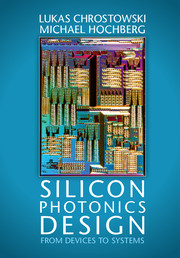In this chapter, we discuss the impact of manufacturing variability of silicon photonic integrated circuits. The dominant variations in silicon photonics are silicon thickness and feature size. These variations appear from wafer to wafer, as well as within a single photonic integrated circuit. Smoothing due to lithography is also important to consider. Methods of including these variations in the design process are discussed. Finally, some experimental results from on-chip test structures are presented to illustrate the manufacturability and non-uniformity challenge of silicon photonics.
Fabrication non-uniformity
Photonic integrated circuits (PICs) often require precise matching of the central wavelength and the waveguide propagation constants between components on a chip (e.g. ring modulators, optical filters), particularly for wavelength division multiplexing. Understanding the fabrication variability is critical to developing strategies (e.g. thermal tuning) for system implementation, and for determining the cost implications for such compensation strategies (e.g. power consumption).
There have been several studies on the fabrication non-uniformity including intradevice uniformity (e.g. CROWs [1]), within-wafer, wafer-to-wafer, and batch-to-batch variations [2–5]. The dominant fabrication parameter that results in device variation has been identified to be the silicon thickness variation, followed by lithography (e.g. waveguide width) variations.
Zortman et al. [2] found that the thickness variation across 10 cm led to ± 1000 GHz variation in TE resonator wavelength, whereas the width variation contributed to ± 200 GHz. From measurements of TE and TM resonators, they extracted the dimensional variations to be ±5 nm in both thickness and waveguide width (or diameter). The reader is also referred to References [3, 5]. In [5], TE-polarization Bragg gratings, using both strip and rib waveguides, were used to extract thickness variations of approximately ±5 nm, which led to resonance shifts up to 10 nm; these results are consistent with Reference [2].
An example of fabrication non-uniformity, and its impact on device performance, is shown in Figure 11.1. The devices are Bragg gratings, with lengths ranging from 325 µm to 4.9 mm.
